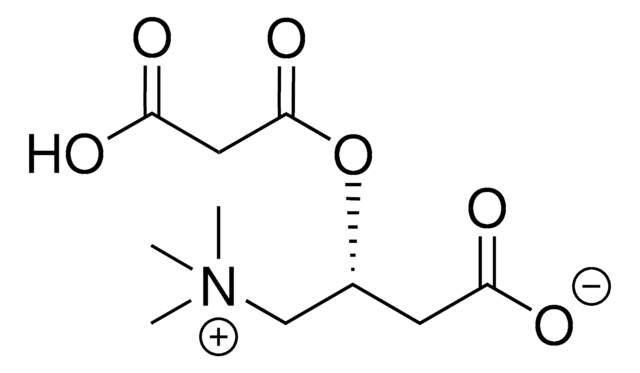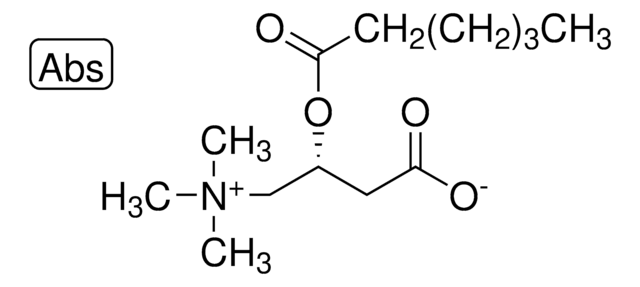72715
Glutaryl-L-carnitine lithium salt
≥98.0% (TLC)
Sinonimo/i:
L-Carnitine lithium glutarate
About This Item
Prodotti consigliati
product name
Glutaryl-L-carnitine lithium salt, ≥98.0% (TLC)
Livello qualitativo
Saggio
≥98.0% (TLC)
Forma fisica
solid
Attività ottica
[α]/D -20±2°, c = 1 in H2O
Impurezze
≤10% water
Colore
white to off-white
Temperatura di conservazione
2-8°C
Stringa SMILE
C[N+](C)(C)C[C@H](OC(CCCC(O)=O)=O)CC([O-])=O.C
InChI
1S/C12H21NO6/c1-13(2,3)8-9(7-11(16)17)19-12(18)6-4-5-10(14)15/h9H,4-8H2,1-3H3,(H-,14,15,16,17)/t9-/m1/s1
NXJAXUYOQLTISD-SECBINFHSA-N
Cerchi prodotti simili? Visita Guida al confronto tra prodotti
Categorie correlate
Azioni biochim/fisiol
Comunemente ordinati con questo prodotto
Codice della classe di stoccaggio
11 - Combustible Solids
Classe di pericolosità dell'acqua (WGK)
WGK 3
Punto d’infiammabilità (°F)
Not applicable
Punto d’infiammabilità (°C)
Not applicable
Certificati d'analisi (COA)
Cerca il Certificati d'analisi (COA) digitando il numero di lotto/batch corrispondente. I numeri di lotto o di batch sono stampati sull'etichetta dei prodotti dopo la parola ‘Lotto’ o ‘Batch’.
Possiedi già questo prodotto?
I documenti relativi ai prodotti acquistati recentemente sono disponibili nell’Archivio dei documenti.
I clienti hanno visto anche
Il team dei nostri ricercatori vanta grande esperienza in tutte le aree della ricerca quali Life Science, scienza dei materiali, sintesi chimica, cromatografia, discipline analitiche, ecc..
Contatta l'Assistenza Tecnica.








![[(3R)-3-Hydroxyhexanoyl]-L-carnitine analytical standard](/deepweb/assets/sigmaaldrich/product/structures/529/281/b2c430b9-0eaf-42c2-9f83-291338e64187/640/b2c430b9-0eaf-42c2-9f83-291338e64187.png)
